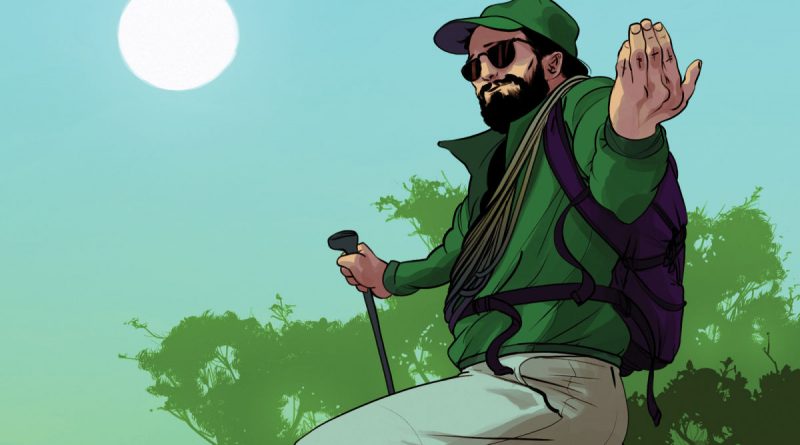38 Adventure Secrets from Professional Wilderness Guides
Leave it to the pros to have the outdoor world figured out. These tips are what turn hikers into guides—and guides into heroes.

1. Get ready faster.
The easy way? Don’t unpack. When you finish a weekend trip, leave all the stuff you use for nearly every adventure—stove, sleeping pad, first-aid kit, repair kit—together in your pack. Have an organized rack or bin for each sport: climbing, paddling, etc. That way, you can just add activity-specific items and clothes to fit the trip and you’re ready to go.

2. Build your endurance.
Everyone who’s ever hired a guide has seen “guide strength.” Bryan Pope, of Earth Native Wilderness School, reveals his workout.
Form is paramount; improper body position risks injury. This workout uses light weights (15 pounds, max; none if you’re just getting started), common exercises, and lots of reps to build lean muscle for all-day strength.
Combine this workout with a 3- to 7-mile hike or run, three days a week.
Lower Core Circuit (x3)
Quads/Glutes: 20 reps each
Sumo squats
Squat side-walk with exercise band
Hamstring: 20 reps
Bird dogs
Hips: 20 reps
Scissors
Calves: 20 reps
Calf raises
Core/Back: 20 to 30 reps each
V-ups
Beetles
Upper Core Circuit (x3)
Chest: 20 reps each
Pushups
Single-arm chest press
Back: 20 reps each
Pull-ups
Reverse flies
Shoulders: 20 reps
Arm circles
Triceps: 20 reps
Bench dips
Biceps: 20 reps
Zottman curls
Core/Back: 20 to 30 reps each
Russian twists
Supermans
Complete step-by-step instructions (with photos)
3. Pack for density.
Gear lashed to the outside of your pack is less secure. To get everything inside, pack up tight. I roll my sleeping bag up, wrap my ultralight sleeping pad around it, then put them in a compression sack. That saves almost half the space. –Matt Schonwald
4. Dial in Your Gear.
We were on the Spearhead Traverse in British Columbia, and one client had purchased ski crampons before the trip but never learned how to put them on. There’s no excuse for getting into the field with gear you don’t know how to use. Ask the salesperson, experiment at home, use YouTube. Whatever works. –Shane Robinson
5. Bring Less Fuel.
If you’re making freeze-dried foods for dinner, presoak the meals while you’re setting up camp to reduce fuel consumption and cooking time.
6. Get Psyched!!
I remember walking into a rock gym with a client—a young guy in his 20s, who was just getting back into athletics after losing an arm serving in Iraq. He took one look at the wall and said, “Ah, I’m f****d, I can’t do this.” It was time to get our psych up. I told him to take 10 minutes to clear his head of all expectations. Then, we broke the whole challenge down into achievable steps and developed an action plan for each step. In so doing, the client and I freed our minds from the idea that climbers must have two arms. He made a few moves up the wall, got some momentum—and then realized he could do it. The smile on his face after he lowered down off the top was all-time. –Rob Coppolillo

7. Know Why You Came
I guide out of New York City, and every vanload of clients I drive up to the Catskills seems as diverse as the city itself. I often feel like a gateway from the streets to the summits.
Recently, I was guiding two women in their late 50s. They were Brooklyn-born and raised and said they’d never been hiking before. Both seemed pretty fit and moved well up the trail to 3,720-foot Panther Mountain.
At the summit, they embraced and were more moved by the moment than anyone else I’d ever guided in nine years of doing this. Curious, I asked why they were feeling it so hard, and they said that two years earlier, they’d each received diagnoses from their doctors that the onset of diabetes was not a question of if, but when. They’d both decided that day to end their sedentary lifestyles. Soon after, they set a goal to climb a mountain—any mountain. That was their vision and how they stayed motivated. Over the next two years, they’d worked at their goal, losing 180 pounds between them.
And while that Catskills peak might have seemed like Everest to them, they had one thing that all successful adventurers have: humility. They’d set their goals way out in the future and worked toward them over time. They didn’t act entitled; they didn’t think the mountain owed them anything. They were there to make good on a promise they made to themselves. The mountains were just a venue.
To see that in action, well, that’s not only why I guide—it’s why I go outside, too. –David DiCerbo
8. Carry less water.
For warm days on snowfields, pack a bit of snow into your water bottle every time you sip from it (starting when it’s full). Dig down away from the surface to find snow with higher moisture content.

9. The Perfect Hoodie
On cool days, guides reach for lightweight softshells for versatile layering. “I need my Rab Sawtooth Hoodie,” Rob Coppolillo says. “I ski tour, ice climb, and rock climb in it. It’s breathable and durable.”
$180; 1 lb. 4 oz. (m’s L); m’s S-XXL, w’s XS-XL
10. Pack Miso.
This easy-prep soup is perfect for both cold mornings and evenings when you want something savory—and it replaces lost electrolytes.

11. Deal with Bugs.
You can’t prevent bugs. But there are a few different ways to manage them. Sometimes I’ll use natural bug spray on exposed skin. In extreme conditions, I’ll use a head net. But if you just cope with some bites, your body starts to recognize the irritant and produces less of a histamine reaction. –David DiCerbo
12. Talk to a Struggling Partner
When mountain conditions are good but your buddy hits a mental wall, it’s time to play backcountry shrink. Get him to open up about the things that are holding him back. In my experience, it’s rarely physical and almost always nerves or fear. When that’s the case, look at him and say, “You can do this. I got you.” It sounds trite until you try it and your partner starts to crush again. –Charlotte Austin

13. A Rigid Chair
A chair with rigid support might save more butts than your own. “I’ve used my Crazy Creek to set a broken leg and as a sleeping pad when a client forgot one,” David DiCerbo says.
$51; 1 lb. 10 oz.
14. Make dinner into soup.
Adding an extra ½ cup of water to freeze-dried dinners tricks you into consuming more liquids. Bonus: Meals with more water are also easier on
the stomach.
15. Gain elevation slowly.
If you’re not acclimatized, hang back with the slowest people in your group during climbs. The mellower pace gives your body a chance to get used to the thinner air and helps curb altitude sickness.
16. Make your fire feel hotter.
Position a space blanket behind the flames so it reflects heat back at you.
17. Master the Poop Prank
Bring a candy bar you can reasonably shape into animal poop. Run up the trail and hide it—or drop it in camp early in the morning before people wake up. Prime everyone to look for animal sign. Eventually, someone will spot it and ask you to take a look. First, study it from a distance. Then get down a little closer and give it a sniff. Dip your finger, then quickly put the finger in your mouth. It’s always good for a horrified laugh. –David DiCerbo

18. You Can’t Fix Crazy
When people summit Mt. Vinson, the high point of Antarctica, an interesting thing happens: They’ve spent so much time, life, and money to complete one of the world’s most exotic trips, but all they want to do is get home.
A few years ago, I had a Serbian client whose desire to get home bordered on desperation. While the rest of the team was eating lunch, he asked to begin walking. I told him he could go to the edge of camp and wait for the group to clip in for a traverse of the Branscomb Glacier.
He crossed the threshold of camp, dragging his plastic utility sled, and then—boop!—dropped out of sight.
I radioed co-guide Chris Simmons, whose group was about an hour ahead, to look for my guy and clip him in.
“OK, we see him,” Simmons radioed, 20 minutes later. “Yep. There he goes.”
“What do you mean, ‘There he goes?!’” I responded.
“I don’t know how to explain this to you,” Simmons said, “but he’s riding his sled like a skeleton luge, head-first down the Branscomb Glacier. He just passed us.”
In the background, I heard a loud “Wahoo!” as our Serbian friend ripped past the group. (He ultimately made it down.)
What can you do with someone set on endangering himself? Don’t let him endanger anyone else. It’s your duty to try and talk him out of it, but not to follow him into peril. Everyone’s life is in his own hands. Even if those hands are gripping a plastic sled hurtling through a crevasse field. –Mark Allen
19. Pitch a tarp.
In warm weather, unless you’re in scorpion country, ditch the tent. If you get proficient with a tarp, you can stay dry in almost any conditions. Start with a tarp that measures at least 8 by 10 feet. Look for a sheltered, well-drained spot and find trees spaced about 12 feet apart—or use trekking poles. String a ridgeline 3 to 4 feet high. Keep the wall edge close to the ground if it’s rainy. If it’s nice, pitch the head side higher (around 5 feet) for better ventilation. If stringing between trees, use a clove hitch on one side and a tensioning trucker’s hitch on the other. If fastening between trekking poles, use a clove hitch around each pole and a trucker’s hitch around stakes, roots, or rocks. Anchor the tarp’s edges close to the ground.
20. Make sure your pee bottle is tightly capped.
21. Never lose your stuff.
Label all your gear on group trips. Everything I have is tagged with turquoise duct tape. –Charlotte Austin
22. Sleep Warmer.
Don’t sleep in a cold sink, such as a river valley, stream-bottom meadow, or canyon.
Drink a hot beverage before bed.
Pack dedicated sleep socks so your feet don’t get cold.
Bring a hot water bottle into your sleeping bag on especially cold nights.
Go to bed warm: Do sit-ups if necessary.
Pee before bed and whenever the urge strikes. Your body wastes calories keeping urine warm.
23. Pitch a tent in high winds.
Orient the tent so the smallest side faces the wind. Stake down the body, then erect the poles. Bunch up the fly and clip it onto the tent’s windward side first, then spread it over the top.
24. Keep water from freezing in winter.
Fill your biggest cookpot three-quarters full of water and cover. Dig a pot-size hole in a snowbank, insert your pot, and pack snow around it. Your water will still be liquid come morning.
25. Eat for taste.
Sometimes clients will tell me, ‘Hey, I don’t feel good,’ and then say they ate 19 GU packets. Of course you don’t feel good! Eat tortillas and lunchmeat, candy bars, cold pizza; your body knows how to process them, and they’re palatable even at altitude. –Charlotte Austin

26. Get cell reception (almost) anywhere
The trick is to climb high, then toggle in and out of Airplane Mode: Phones are at their strongest right when they acquire a signal. If it’s an emergency, text your pre-determined contact and include the victim’s name, age, condition, and location and type of rescue you need.
27. Conserve batteries.
In an emergency, use only one cell phone at a time and turn the others off. Use that phone until it dies; repeat with the other phones.
28. Do Sunscreen Right.
Snow and water reflect UV rays back up from the ground. For complete sun protection, dab the underside of your chin and the insides of your ears and nostrils.
29. Warm cold extremities
Swing your arms in circles and pendulum your feet back and forth (separately, unless you’re very coordinated). Don’t stop until your digits start to throb.
30. Speak the Language of Risk
Improve group decisions and dynamics by avoiding these common rhetorical cul-de-sacs.
Poor communication is part of every accident, whether it’s people misunderstanding each other or the conditions. Matt Schonwald takes you through a better technique.
AVOID “That looks dangerous.” Subjective declarations divide groups.
SAY “How does that look?” Let everyone’s opinions be heard before making a decision to continue.
AVOID “We made it all this way. So let’s do it.” The perception of sunk costs creates a cognitive bias against things like changing conditions, energy levels, and group dynamics.
SAY “What are the conditions telling us?” Be honest with your assessment—because nature doesn’t suffer hubris lightly.
AVOID “So are we doing it? Yes or no?” Such talk creates false urgency and forces group members to commit to a course of action regardless of changing circumstances.
SAY “How is everyone doing right now?” Use regular check-ins while moving through difficult terrain, and don’t pose questions with binary answers.

31. Heavy-duty Cordage
When choosing multipurpose rope, go stouter than p-cord. “The most simple, versatile piece of equipment I have is 20 feet of 7mm cordelette,” Mark Allen says. You can use it to secure your tent in high winds, gauge the angle of a slope in a whiteout by whipping it down the mountainside, perform a crevasse rescue, or use it as a leave-behind sling.
$17; 7 oz.

32. React and Adapt
We had just come down from Camp One on Everest in 2015 when the ground started to shake. I was in the tent with one of my regular clients, Brad. He asked if we should stay inside, and I said we should get out and see what was up.
I looked toward the Khumbu Icefall, where 16 sherpas died the year before, expecting to see the mountain’s shoulder come down. I didn’t think to look behind me. Brad turned around and yelled that a powder cloud was coming off Pumori.
“What do we do?” he shouted.
There were little moraine hills around us and I yelled and pointed to take cover. I ran one way and he ran the other.
Tons and tons of fine snow poured over me, with the moraine acting like a break. When I realized I was all right, I got up. Brad’s shoe had been knocked off, but he was OK, too. Our camp was battered but standing. Beyond that, carnage.
Most people who sheltered behind rocks were fine, but those who stayed in their tents were smashed around. Their tent poles broke and many of them were stabbed to death by the jagged ends. We immediately went into rescue mode.
There is no control in a disaster of that magnitude, but you’ve got to try. Just like at the start of the avalanche, we had to make decisions, and quickly. Guides formed recovery teams and set up triage despite language barriers. Sure, we had only rudimentary gear and first-aid supplies. But we didn’t wait for help. Everyone who made it through that first night ultimately survived. –Dennis Broadwell
33. Make a can’t-miss meal.
Backcountry Pad Thai. 1 serving
1 cup rice noodles
1 cup green onions, chopped
¼ cup bell peppers, chopped
¼ cup jalapeño, chopped
6 slices tempeh
¾ tsp. ginger, minced
1 Tbsp. garlic, chopped
2 Tbsp. powdered peanut butter
Add noodles, veggies, peanut butter powder, and spices to 2 cups of boiling water and cook for 3 to 5 minutes. Remove from heat to let thicken. Sauté the tempeh, add to noodles, and serve. –Matt Schonwald
34. Camel up.
Staying hydrated makes your body more resilient during dry spells. If water is scarce, tank up during the night. Your cells have more time to absorb water when you’re not sweating it out immediately.
35. Protect your nose.
Got a runny nose? Use lip balm on it rather than sunscreen; it will adhere better.
36. Perform an idiot check.
Before hiking, look up at the weather and terrain ahead, and down at your feet (make sure your bootlaces are tied). Then, five steps after you’ve left, look back to make sure you didn’t leave anything behind.

37. Versatile layer
“No matter what I’m doing in the outdoors, I’ve got a Buff,” says Matt Schonwald. “It’s effective as sun protection, insulation, and even first aid.”
$20; 1.3 oz.
38. Tip your guide.
Consider it mountain karma.
The All-Stars
We talked to outdoor professionals from across the country to source their best advice. Meet the team:
Mark Allen, Mountain Bureau
Charlotte Austin, International Mountain Guides
Dennis Broadwell, Mountain Gurus
Rob Coppolillo, Vetta Mountain Guides
Jodie Darensbourg, Outdoor Educators Institute
David DiCerbo, Destination Adventure Guides
Rena Payan, Outdoor Educators Institute
Bryan Pope, Earth Native Wilderness School
Shane Robinson, Pro Guiding Service
Matt Schonwald, BC Adventure Guides
Brenda Walsh Hollon, International Mountain Guides
The article was originally seen at https://www.backpacker.com/skills/mountain-guide-secrets
Originally posted 2018-03-27 14:15:19.




